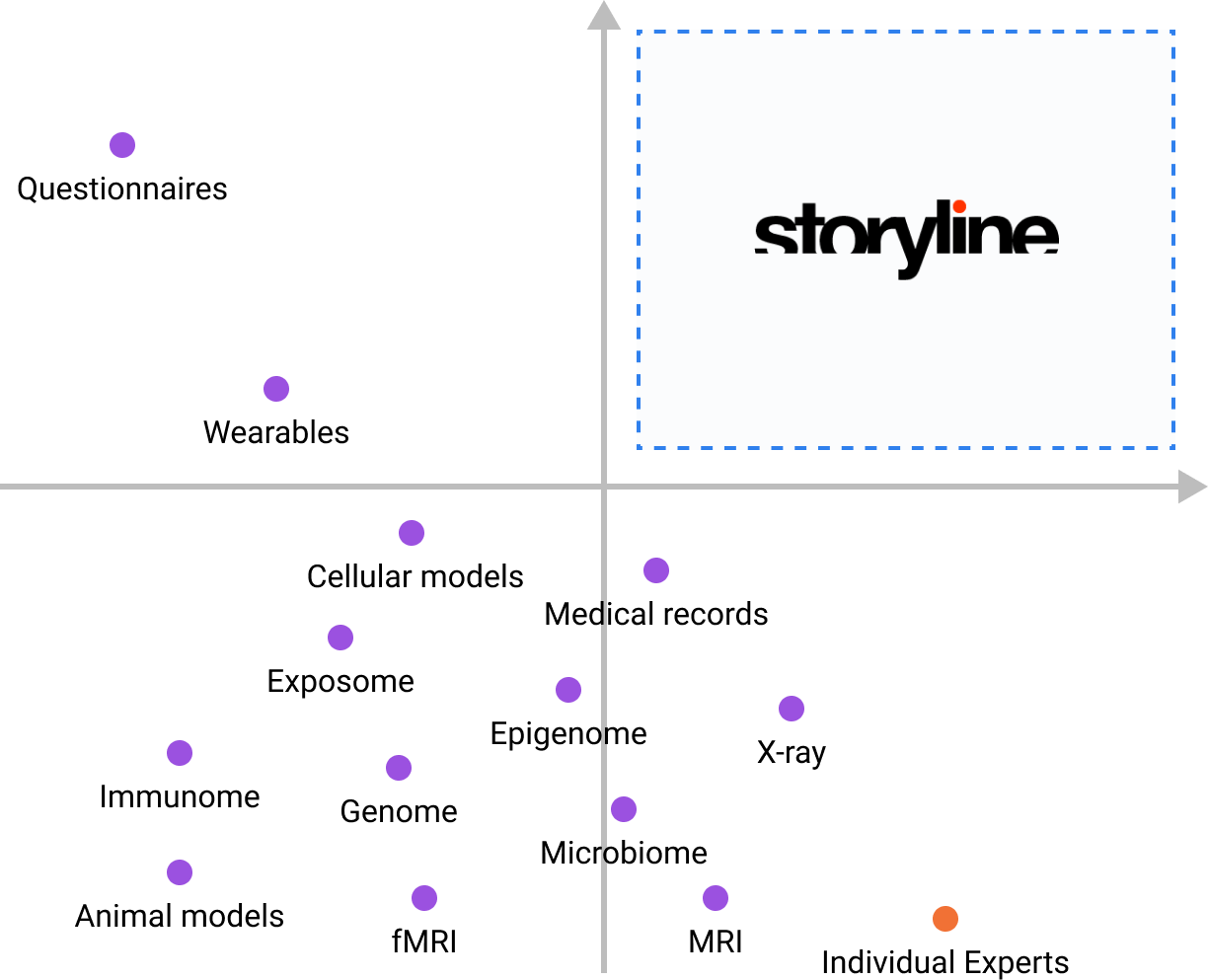
Mindreader
Capture, understand, and use the infinitely variable, individual, and complex data available in human behavior. Yeah, it’s that cool.
What data feels like when the leash breaks.
Storyline captures dynamic behaviors, sentiments and expressions from patients - extracting more than >20,000 different measurements and features from video, audio, and language at blazingly fast speeds up to 24 times a second. Then we organize that data to allow researchers to find and uncover new behavioral biomarkers of health and disease. Storyline provides the data to move your research or care from art, to science.
Smarter than the next 25,000 experts combined.
Storyline replaces generic consensus and biased opinion with hard science. A clinician might be an expert after seeing a hundred similar patients, or a thousand. Storyline is built to capture, understand, and use trillions of data points from millions of patients. Smart, huh?
1,000,000x more data. 1% of the cost. You do the math.
Storyline captures data that’s never been seen before. Finally, we have the data resolution needed to understand and use the almost infinitely variable, individual, and complex information encoded in human behavior.
Cheap & Scalable
Expensive & Manual
High value
Diagnostic & Predictive
Low value
Not diagnostic or Predictive

It captures 1,000,000x more data than medical records, extracts 290,000 dynamic behavioral measurements a second, and opens entirely new areas for research and care.
Calling it behavioral A.I. seems rather limiting.
1-time use
The 3B base
genome sequence
Usefulness
Continuous, unlimited use
millions of micro-feature
measurements over time
Highly sensitive and predictive.
The nervous system detects metabolic, inflammatory, endocrine and physical changes, as well as cognitive, emotional and environmental changes.
Genomics
Behavior
Research and discovery, Disease diagnosis, disease risk and progression prediction, treatment selection, treatment efficacy monitoring, side effect detection & prediction, treatment compliance, monitoring of health changes, adaptive and personalized care models.
Not very predictive or diagnostic
Genome sequence
doesn’t change.
Predictive Value
Application
Data Output
FASTQ files
Variant call files
SAM files
StoryARC files
StoryTIME files
ScreenPLAY files
POEM files
Scalability & Cost
Limited
Expensive
Unlimited
Cheap
Research and discovery, Disease risk prediction, treatment selection, personalized care models
Behavior: more valuable than Genomics
Why behavioral data is so much more powerful than genomic data.
Storyline vs. Forms, Surveys, & Questionnaires.
Entirely new data value curve.
Behavioral factors are the primary effectors of cancer risk, patient outcomes, and quality of life.
Behavior >90% risk
Treatment compliance
Social support
Nutrition
Self-care (eg. physical activity)
Lifestyle (eg. smoking, alcohol addiction)
Environment (eg. toxin exposure)
Education
Employment & Income
Mental health
Access to care
Genetics <10% risk
Inherited risk
Sources:

For those finding it hard to believe we could fit the infinite variability, individuality, and complexity of human behavior into a data file.
Voila.
Behavior is a blue ocean of opportunity.
Healthcare, research, business… unique data creates massive value – unique compounds for drug development (Genentech, Merck, Pfizer), genomic sequencing (Illumina, Genentech, Myriad), and consumer data (Google Health, Fitbit, 23andMe).
But the data tools you’re using hasn’t changed since the 1940’s. – EMR, lab tests, forms, surveys, and questionnaires… they’re useful, but they’re just flat, static records. (Moving them online doesn’t change the data.) It’s the same information everyone has, and it’s a red ocean of cutthroat competition where the biggest wallet wins.
But behavior is a blue ocean.
Behavioral data is dynamic, complex, and individual. It’s the richest, most predictive, and most valuable data we use. Patient behavior is the primary information that every clinician uses to evaluate a patient and make clinical decisions, and the reason that you can’t treat a patient until you see a patient.
Behavior contains the information we need to find new behavioral biomarkers that link to the underlying biology and uncover the path to scalable precision care, for everyone.
That’s why we built Storyline – to give every scientist, researcher, or clinician access to the the worlds best behavioral discovery tools.
First, we make data capture so amazingly easy that you’ll feel that it’s magic – and it kinda is.
Storyline extracts tens of thousands of features a second from video, audio, and natural language — using deep learning A.I. to measure both conscious and unconscious behaviors that are unimaginably complex and imperceptible to humans.
From facial features we track movement, blinking rates, micro-expressions, facial symmetry, emotional responses, glances, eye movement, blood flow patterns, skin pallor, heart rate, respiration…
From head and body movements we can view gestures, hand movement, twitching, weight shifting…
From the audio we’re separating and evaluating vocal micro-tremors, pitch changes, phonemes, clipping, shimmer, pronunciation, tone..
and from language we’re capturing every utterance to understand word choice, complexity, topic switching, pauses, patterns, and variation.
This massive dataset is analyzed to reveal changes and variations; cognitive load, topic switching, personality, creativity, stress and anxiety, pain, comfort, distress, and thousands of other measurements that reveal the most critical information.
Then we make that information easily usable, de-identifying that data and organizing it in StoryARC, StoryTIME, ScreenPLAY, and POEM files – so that you and others can use your existing research tools.
Finally, we return scores and data visualizations with StoryBOARD.
Behavior is the data that will allow for scalable precision care, for everyone, everywhere.
So, before you write your next grant or go into your next trial blindfolded, can we humbly suggest that you take a peek and see for yourself what Storyline can do for you, and your work.
Data in a whole new class.
Sometimes it helps to talk to someone who talks data, and science.


